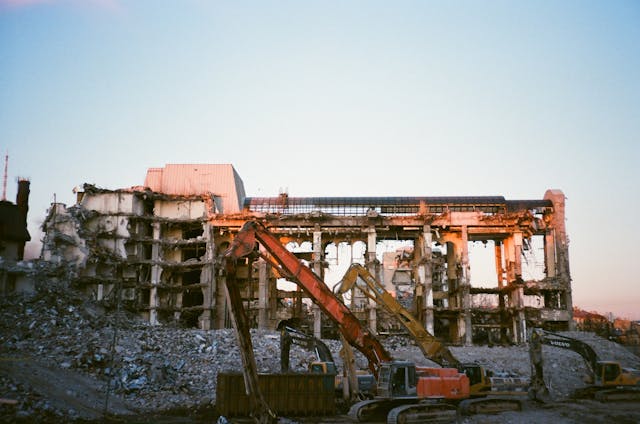
- Safety is paramount in demolition; it involves careful planning to minimize risks and protect workers and bystanders.
- Financial planning is necessary to cover unexpected costs, ensuring the project stays within budget constraints.
- Logistical coordination is crucial for streamlining operations, avoiding delays, and managing waste efficiently.
- Compliance with regulations is essential to avoid fines/legal issues, requiring up-to-date knowledge of all relevant laws.
Demolition projects are complex undertakings that involve many moving parts. From obtaining permits to ensuring safety protocols are followed, numerous challenges can arise during the demolition process. This blog will explore significant challenges that commonly occur in demolition projects and discuss strategies for overcoming them.
Safety and Security

One of the biggest challenges in demolition projects is ensuring the safety of workers and bystanders. Demolition sites can be hazardous environments, with potential risks such as falling debris, structural instability, and exposure to harmful materials. To mitigate these risks, here are four key strategies to incorporate into your demolition project plan:
Conduct Thorough Site Assessments
Before beginning any demolition work, it’s crucial to thoroughly assess the site and identify potential hazards. This should include identifying any hazardous materials present on the site and determining the structural integrity of buildings or structures that will be demolished.
Develop a Comprehensive Safety Plan
Based on the site assessment, a comprehensive safety plan should be developed and implemented. This plan should outline specific protocols for each stage of the demolition process, including how to handle hazardous materials, proper use of equipment, and emergency procedures.
Provide Proper Training and Equipment
All workers involved in the demolition project should receive thorough training on safety protocols and proper handling of equipment. It’s also essential to ensure that all workers have access to necessary personal protective equipment (PPE) and are trained on how to use it correctly.
Regularly Monitor and Inspect the Site
As demolition work progresses, it’s essential to regularly monitor and inspect the site for any potential hazards or safety issues. This can help identify any problems early on and allow for corrective action to be taken before they become more significant issues.
By implementing these strategies, you can help create a safer work environment for everyone involved in the demolition project. It’s also important to note that safety is an ongoing process and should be continuously evaluated and improved upon throughout the duration of the project.
Environmental Concerns
Another challenge in demolition projects is managing environmental concerns. Demolition activities can release hazardous materials such as asbestos, lead paint, and other contaminants into the air and soil if not properly handled. It is crucial to conduct thorough environmental assessments before starting a demolition project and take appropriate measures to contain and dispose of any hazardous materials safely.
Cost Overruns
Cost overruns are another common challenge in demolition projects. Unexpected expenses can arise due to factors such as unforeseen structural issues, delays in obtaining permits, or changes in project scope. To prevent cost overruns, it is essential to conduct a thorough site assessment before beginning the project, create a detailed budget with contingency funds built-in, and closely monitor expenses throughout the demolition process.
Logistical Challenges

Logistical challenges also play a significant role in demolition projects. Coordinating the removal of debris, transporting heavy machinery to and from the site, and managing traffic flow around the worksite are just a few examples of logistical hurdles that can arise during a demolition project.
Proper planning and communication between all stakeholders are vital in overcoming logistical challenges and ensuring that the project stays on schedule. You should also ensure you have the right equipment and resources in place to efficiently handle all aspects of the demolition process.
For example, you may need to rent out a roll-off dumpster for the removal and disposal of debris. Choose a dumpster size that can accommodate the amount of debris you expect to generate during the project and schedule regular pickups to avoid excessive buildup and potential safety hazards.
Regulatory Compliance
Finally, regulatory compliance is a significant challenge in demolition projects. There are numerous federal, state, and local regulations governing demolition activities that must be adhered to throughout the project. Failure to comply with these regulations can result in fines, legal action, or even stop-work orders. It is essential to stay informed about all relevant rules and work closely with regulatory agencies to ensure full compliance at every stage of the demolition process.
Demolition projects pose challenges like safety concerns, financial planning, logistical hurdles, and regulatory compliance. However, thorough preparation and strategic planning can significantly reduce these issues. By prioritizing safety, budgeting wisely with contingencies, planning logistics meticulously, and strictly adhering to regulations, demolition projects can be executed smoothly.
The key to overcoming demolition complications lies in attention to detail—safety protocols, financial planning, logistical coordination, and regulatory compliance are crucial for successful completion. Streamlining these aspects ensures the safety and efficiency of the project, highlighting the importance of comprehensive planning in demolition projects.
